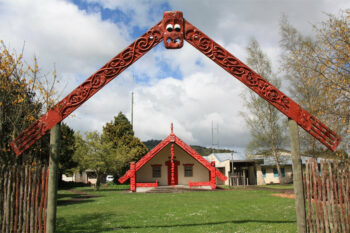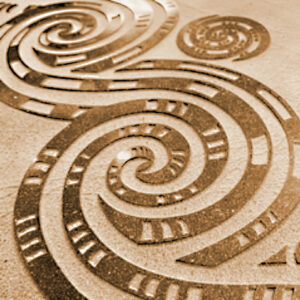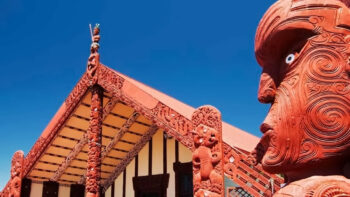Takarangi – Importance of Space

By Pā Piripi Cody SM
Part 2: Māori Cultural Insight

Takarangi - revolving heavens
One area that is a carefully designed space in Māoridom is the marae atea. This is the space in front of a meeting house, often bounded by trees and grassed. It is the space between the car park and is the arrival gathering area before visitors engage with and actually meet the local people.
Sir Mason Durie in a booklet1 on ‘wellbeing’ states, “the marae atea is a place where relationships are negotiated. If the proper engagement takes place then empowerment in relationship will follow”.

The marae atea in front of the wharenui at Morero Marae, Taumarunui
First, there is a certain ‘distance’ between people. It is important to stay comfortably apart before meeting personally. This space can allow for testing who is here, announcing the purpose of gathering and focussing on what is important; time to recall the past and those who have died, who have laid the path for us; talking about our history and family links and following processes that will be honest and lead to cementing a bond.
Hence the calling on (karanga); the talking (whaikōrero); the meeting (hongi); and finally gathering to share some refreshment (kai or hākari). Space and timing provide safety, sharing and finally personal meeting ‘face to face’ (kanohi ki te kanohi). We need space to be connected!
 Let us look at a symbol in Māori life and carving that illustrates this. It is called ‘Takarangi’.2 Literally, the ‘revolving heavens’. Life is like a rotating journey.
Let us look at a symbol in Māori life and carving that illustrates this. It is called ‘Takarangi’.2 Literally, the ‘revolving heavens’. Life is like a rotating journey.
The Takarangi is an intersecting double spiral pattern. These two parallel spirals signify our journey. On one hand, our beginning; on the other, our moving on in life. The spirals signify our celestial origin born at the beginning of the Universe. They symbolise too the completion of life’s journey.
The intersection of the spirals indicates the close relationship of Earth and Sky, Papa and Rangi. It is rather like the magnetic attraction of positive and negative poles, of North and South, East and West.
It is precisely in the separation of the two that we can have light and see what life is about. What is important here is the space between the spirals. No space, no light. No space, no understanding. Space is vital. Space enables us to see the spirals. The open space between the two spirals symbolises Te Ao Mārama (The world of light and knowledge) and the link men and women have with the Spirit (Wairua).

Examples of takarangi spirals.
Te Papaiouru Marae, Ohinemutu, Rotorua
In carving, the space is often portrayed by tiny ‘wedges’ or links.
Carved on the prow of a canoe (waka), spirals provide added stability and balance, allowing winds and waves to pass through. We need the ‘space’ to balance, to steer safely, to join our past, present and future.
Once we can see clearly we will know how to live now and into our future. Hence, the Takarangi spirals adorn many carved meeting houses (wharenui)
A Māori term for this ‘space’ is ‘te wā’. It literally means ‘[the] time’. This is space or time to let things unfold. Time to breathe. Time or space to reflect. Time or space to absorb. Time to nurture oneself. Time that links past and present. Time to complete a stage of living, time to move on.
There is a lovely section in the Bible which captures this.
“To everything there is a season,
and a time to every purpose under heaven:
a time to be born, a time to die….”3
There is a common Māori saying when friends part from each other: ‘Mā te wā’. It indicates the on-going nature of time and relationship. ‘Till later on’. ‘All in good time’ ‘Mā te wā’.
Te wā (time / space) links us with our genealogy, or family tree. I can be proud of my ancestors and link with my home country. In Māoridom a ‘family tree’ is reversed and builds from the ground up. We are ‘grounded’ in the links we have with our family. We have a beautifully connected set of links with Earth and all nature and all people. Hence the importance of taking time or space to renew this.
I recall a lovely Kuia, Mihipeka Edwards. She helped me a lot with learning te reo Māori. When we left, she would say, “A tōnā wā ka tutaki tāua” (Till the two of us meet again at the right time).
Everything has its proper ‘space’ or time. There will be a ‘right time’ for us to catch up in person again.
Just as the spaces between the spirals of Takarangi carving ‘pause’ their movement to relate and connect, so, if we embrace the value of space and time, we will live healthy and fulfilled lives.
Ā tōnā wā!
1 Durie, Mason, Māori Concepts of Wellbeing, Palmerston North 2013. Seminar notes.
2 Some sample references:
www.tuwharetoabone.com/blogs/news/te-takarangi-maori-carving
www.nzetc.victoria.ac.nz/tm/scholarly/tei-BucTheC-t1-g1-t2-body1-d14-d12.html
3 The full text is Ecclesiastes 3:1-8
 Entries(RSS)
Entries(RSS)